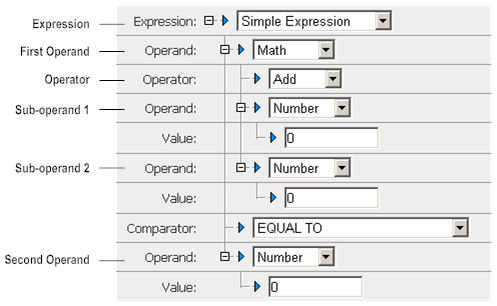Defining Math as the First Operand
The specific steps for defining each of the two operands in a simple rule expression depend on your choice of operand types. The operand type determines the fields that appear in the Rule Expression panel on the Edit Rule Expression page. Each operand type has a specific set of fields associated with it, and whenever you change an operand type, the displayed fields change automatically. If you choose the Math operand type for the first operand in a simple rule expression, Optimize displays the fields shown in the following figure and described in the subsequent task.
Notice that when you choose Math as the first operand type, the first operand is composed of an operator and two subordinate operands. The following task assumes that you have already chosen Math as the first operand type in the Rule Expression panel on the Edit Rule Expression page.

To define Math as the first operand type in a simple rule expression
1. In the Operator list (in the Rule Expression panel on the Edit Rule Expression page), indicate which of the following arithmetical functions you want to perform on the two subordinate operands of the Math operand type:
 Add
Add ([sub-operand 1] + [sub-operand 2])
 Subtract
Subtract ([sub-operand 1] - [sub-operand 2])
 Multiply
Multiply ([sub-operand 1] x [sub-operand 2])
 Divide
Divide ([sub-operand 1] ÷ [sub-operand 2])
2. Specify each of the two subordinate operands and complete the remaining fields for each sub-operand.
Important:
At least one of the operands must be a KPI value.
Note:
You can nest operands by selecting KPI Value or Math instead of Number as the operand type for subordinate operands.
3. In the Comparator list, click the logical comparator (such as Equal To) to compare the two “primary” operands in the simple rule expression (also known as a Boolean expression).
4. In the second Operand list, select an appropriate operand and complete the remaining fields to finish defining the simple rule expression. If you select Number as the second operand, then in the related Value field, you would type the numeric constant that you want to compare to the first operand. If your first operand is of type KPI Value, for example, the unit of measure of your numeric constant must be the same as the unit of measure used by the selected KPI (shown to the right of the KPI's Value selection). For example, if the unit of measure used by the selected KPI is megabytes, Optimize interprets the literal in megabytes.
5. Click Save to save the simple rule expression.

